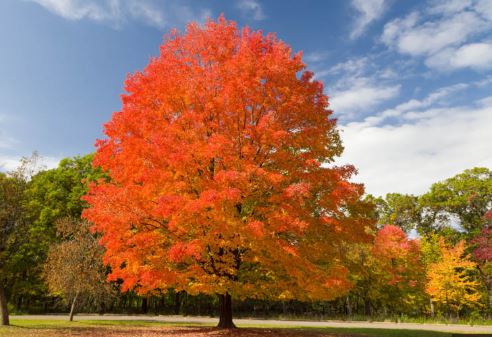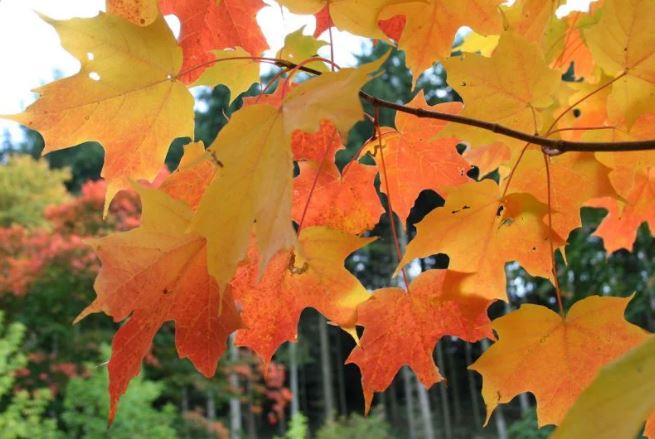
The Sugar Maple (Acer saccharum), often hailed as the king of maples, is a majestic deciduous tree native to North America, celebrated for its vibrant fall foliage, sweet sap, and iconic role in maple syrup production. Its stately form and ecological importance make it a cornerstone of hardwood forests and a beloved ornamental in landscapes.
From shading rural landscapes to symbolizing resilience in Canadian culture, the Sugar Maple captivates with its beauty and utility. In this detailed guide, we explore the botanical classification, origin, identifying characteristics, habitat, distribution, USDA hardiness zones, uses, and fascinating facts about the Sugar Maple.
Botanical Classification, Origin and Native Area
The Sugar Maple, scientifically named Acer saccharum, belongs to the Sapindaceae family, which encompasses maples, horse chestnuts, and lychees. The genus Acer includes over 150 maple species, with A. saccharum classified in the section Acer alongside the Black Maple (Acer nigrum). The species name saccharum, meaning “sugar” in Latin, reflects its high-sugar-content sap, a key source for maple syrup.
As an angiosperm, it produces flowers and seeds, with a typically monoecious reproductive system, featuring male and female flowers on the same tree, though some trees are dioecious. Its taxonomic relatives include the Silver Maple (Acer saccharinum) and Red Maple (Acer rubrum), distinguished by its dense wood and brilliant fall colors, cementing its status as a premier hardwood species.
The Sugar Maple is native to northeastern and central North America, with a history tracing back to the Miocene epoch, as evidenced by Acer fossils. Its range spans from Nova Scotia and Quebec in Canada to Georgia and Texas in the United States, thriving in the cool, moist forests of the Appalachian Mountains and Great Lakes region.
Indigenous peoples, such as the Algonquin and Ojibwe, tapped its sap for syrup and sugar, used its wood for tools, and revered it in cultural practices, embedding it in their traditions. European settlers adopted these practices, commercializing syrup production and planting the tree for shade and timber. Today, it remains a vital species in North American forests and a cultural icon, notably as Canada’s national tree, though its populations face challenges from climate change and urban expansion.
Identifying Characteristics

The Sugar Maple is a large deciduous tree, typically growing 60–80 feet (18–24 meters) tall, with some specimens reaching 100–120 feet (30–36 meters) and a spread of 40–60 feet. Its canopy is dense and rounded, with a straight trunk and smooth, gray bark that becomes furrowed and scaly with age.
Leaves are opposite, simple, and palmately lobed (3–6 inches wide) with 5 lobes, medium green above and paler below, turning brilliant shades of yellow, orange, and red in fall. The tree produces small, yellowish-green flowers in spring, followed by paired samaras (winged seeds, 1–1.5 inches long) that spin to the ground. Its twigs are shiny brown with sharp, pointed buds, and its wood is dense and light-colored, contributing to its distinct silhouette and utility.
Habitat
The Sugar Maple thrives in cool, moist hardwood forests, particularly on well-drained, fertile slopes and uplands, preferring deep, loamy soils (pH 5.5–7.3) rich in calcium. It is less flood-tolerant than other maples, requiring good drainage, and grows best in full sun to partial shade. In natural settings, it dominates mixed forests alongside beech, birch, and hemlock, forming iconic “sugar bushes” critical for syrup production.
Its deep root system stabilizes soils, and its canopy supports diverse wildlife. In cultivation, it adapts to suburban lawns, parks, and urban landscapes, provided soils are fertile and not compacted, though it struggles in polluted or drought-prone environments, making site selection crucial for long-term health.
Distribution
The Sugar Maple is widely distributed across northeastern North America, from Nova Scotia and southern Quebec to northern Georgia, west to Minnesota, and south to eastern Texas. Its core range includes the Great Lakes region, New England, and the Appalachian Mountains, where cool, moist conditions favor its growth.
It has been planted extensively beyond its native range for ornamental purposes and syrup production, appearing in urban areas, rural landscapes, and shelterbelts across the United States, Canada, and parts of Europe. The tree can naturalize in favorable conditions but is not invasive. Its distribution is tied to climatic constraints, with declines in southern ranges due to warming temperatures and habitat fragmentation.
USDA Hardiness Zones
The Sugar Maple thrives in USDA Hardiness Zones 3–8, tolerating minimum temperatures from -40°F to 10°F (-40°C to -12°C). It excels in cool, temperate climates with cold winters and moderate summers, making it ideal for northern regions. In Zone 3, it withstands extreme cold, while in Zone 8, it may require irrigation and shade in hotter, drier conditions to prevent stress. Its sensitivity to heat and drought limits its success in warmer zones, but its cold hardiness and vibrant fall colors make it a staple for landscapes and syrup production in northern climates.
Uses
The Sugar Maple is a powerhouse of ecological, economic, and ornamental value. Ecologically, it provides habitat for wildlife, including birds (e.g., woodpeckers nesting in cavities) and mammals (e.g., squirrels feeding on seeds), while its canopy shades forest understories. Its sap, with 2–3% sugar content, is the primary source for maple syrup and sugar, a multi-billion-dollar industry in North America, requiring about 40 gallons of sap for one gallon of syrup.
The wood, hard and dense, is prized for furniture, flooring, cabinetry, and musical instruments (e.g., guitar necks), valued for its strength and attractive grain. In landscaping, its brilliant fall foliage and stately form make it a premier shade tree for lawns, parks, and campuses, though its slow growth (1–2 feet per year) and sensitivity to urban stress require planning. Culturally, it symbolizes resilience, featured on Canada’s flag and in New England’s autumn tourism.
Fun Facts
The Sugar Maple is rich with captivating facts that underscore its prominence. Its fall foliage, bursting in shades of orange, red, and yellow, draws millions to New England’s “leaf-peeping” season, boosting local economies. A single mature tree can produce up to 12 gallons of sap per season, enough for about one quart of syrup.
Its wood, known as “rock maple,” was used for bowling alley lanes and baseball bats due to its durability. Indigenous legends describe the sap as a gift from the Creator, with traditional tapping methods passed down for generations. Some Sugar Maples live over 400 years, with historic specimens in Vermont standing as living landmarks. The tree’s samaras, or “helicopter seeds,” delight children and aid seed dispersal. Finally, its designation as Canada’s national tree in 1965 reflects its deep cultural resonance, embodying strength and sweetness.
Cultivation of Sugar Maple (Acer saccharum)
Cultivating the Sugar Maple (Acer saccharum), a stately deciduous tree native to northeastern and central North America, is a rewarding endeavor for gardeners, landscapers, and conservationists aiming to enhance landscapes with a slow-growing, iconic shade tree renowned for its brilliant fall foliage and maple syrup production. Celebrated for its dense canopy, hard wood, and ecological value, this tree thrives in cool, temperate climates but requires careful management to ensure healthy growth, given its sensitivity to urban stress, compacted soils, and drought.
- Climate Suitability: Sugar Maple thrives in USDA Hardiness Zones 3–8, tolerating minimum temperatures from -40°F to 10°F (-40°C to -12°C). It prefers cool, temperate climates with cold winters and moderate summers, ideal for northern regions. In Zone 8, provide irrigation and shade during hot, dry summers to prevent stress, as it is less heat-tolerant than other maples.
- Site Selection: Choose a spacious location with full sun to partial shade, receiving at least 4–6 hours of direct sunlight daily, to support its dense, rounded canopy and vibrant fall colors. Ensure the site accommodates its mature size (60–80 feet tall, 40–60 feet wide) and avoid planting near buildings or pavement due to its deep, spreading roots.
- Soil Requirements: Plant in deep, fertile, well-drained soil with a pH of 5.5–7.3, preferably loamy and rich in calcium, mimicking its upland forest habitat. The tree is sensitive to compacted, poorly drained, or alkaline soils, which stunt growth. Test soil drainage and amend with organic matter (e.g., compost, leaf mold) to enhance fertility and structure, ensuring good aeration.
- Planting Time: The optimal planting seasons are early spring or fall, allowing roots to establish before summer heat or winter cold. Dig a hole twice as wide and as deep as the root ball, positioning the root collar at or slightly above ground level. Backfill with native soil, tamp gently, and water deeply to settle the roots and eliminate air pockets.
- Watering Needs: Water young trees deeply (1–2 times weekly) for the first 1–2 years to establish a strong root system, keeping soil consistently moist but not waterlogged. Once established, the tree is moderately drought-tolerant but benefits from supplemental watering during prolonged dry spells, especially in warmer zones or urban settings, to prevent leaf scorch.
- Mulching: Apply a 2–4 inch layer of organic mulch (e.g., wood chips, shredded bark) around the base, extending to the drip line but keeping it 2–4 inches from the trunk to prevent rot. Mulch conserves moisture, regulates soil temperature, and mimics the forest floor, supporting young trees in lawns or parks. Replenish mulch annually to maintain effectiveness.
- Fertilization: Fertilize young trees in early spring with a balanced, slow-release fertilizer (e.g., 10-10-10) to promote steady growth, applying at half the recommended rate to avoid excessive foliage at the expense of root or wood strength. Mature trees rarely need fertilization in fertile soils, as they are adapted to nutrient-rich forest environments. Avoid over-fertilization, which can weaken the tree.
- Pruning: Prune in late winter or early spring, when the tree is dormant, to remove dead, damaged, or crossing branches, using clean, sharp tools to prevent disease spread. Young trees benefit from structural pruning to develop a strong central leader and balanced canopy. Minimize cuts to reduce stress and fungal entry, as Sugar Maples are susceptible to decay if over-pruned.
- Pest and Disease Management: Monitor for pests like aphids, scale, or maple borers, treating infestations with insecticidal soap or neem oil. The tree is prone to verticillium wilt, tar spot, and leaf scorch in stressed conditions; ensure proper drainage, avoid wounding the tree, and remove infected debris to manage diseases. Healthy trees are more resistant, so prioritize optimal growing conditions.
- Spacing: Space trees 40–60 feet apart to accommodate their mature canopy spread, ensuring adequate sunlight and air circulation to reduce disease risk. For ornamental or forest plantings, plant 30–40 feet apart to create a cohesive canopy. Consider their height (up to 80 feet) and root spread when planning near structures or infrastructure to avoid damage.
- Wind Protection: Young Sugar Maples, with deep but developing roots, are moderately wind-tolerant but may need support in exposed sites. Stake newly planted trees for the first 1–2 years using flexible ties to allow slight trunk movement, which strengthens roots. Remove stakes once established to promote independent growth and prevent girdling.
- Winter Care: In Zone 3, protect young trees from winter damage by wrapping trunks with burlap to prevent sunscald and frost cracks, and mulching heavily around the base to insulate roots. Water adequately before freeze-up to prevent dehydration, as deciduous trees can lose moisture in winter. Mature trees are highly cold-hardy and require minimal winter care in most zones.
- Long-Term Growth: Sugar Maples grow slowly to moderately (1–2 feet per year), reaching 60–80 feet at maturity, with lifespans of 200–400 years in optimal conditions. Their brilliant fall foliage, dense canopy, and ecological benefits make them ideal for shade, syrup production, or wildlife habitat in rural or suburban landscapes. Regular monitoring for pests, diseases, and structural health ensures longevity and supports syrup or timber value.